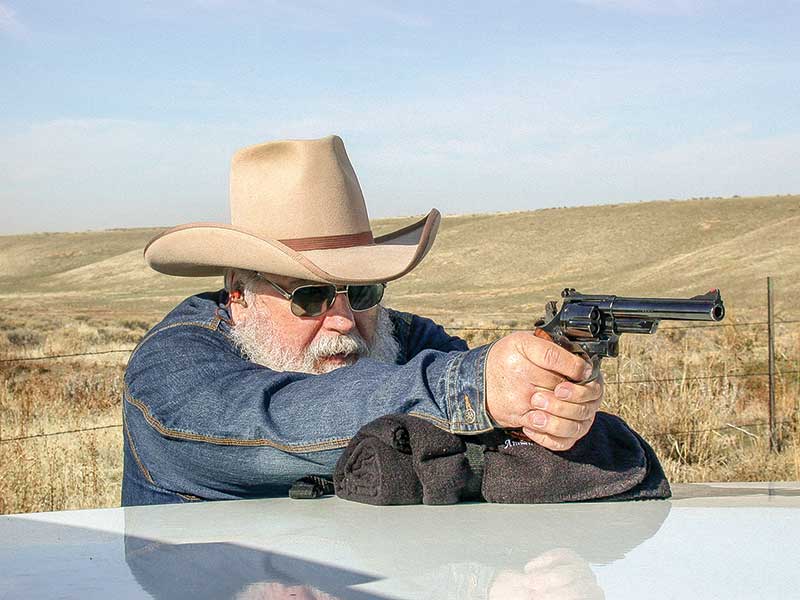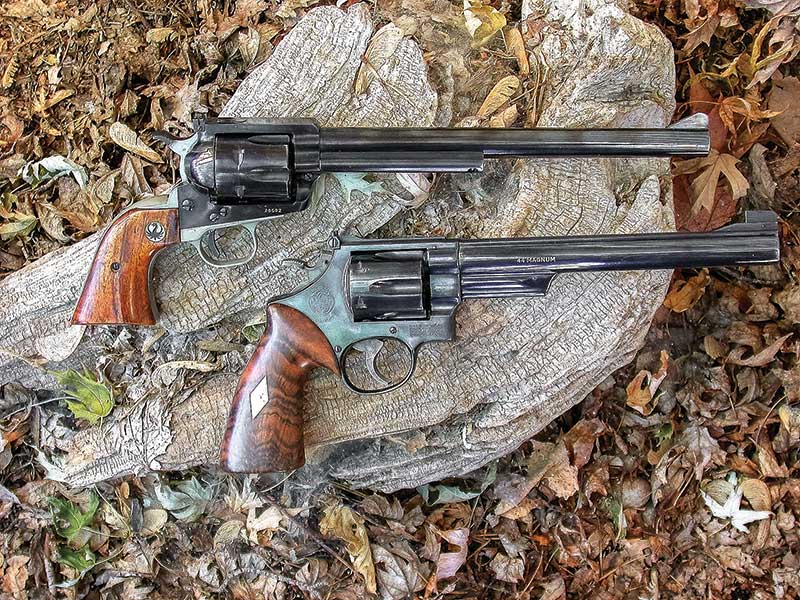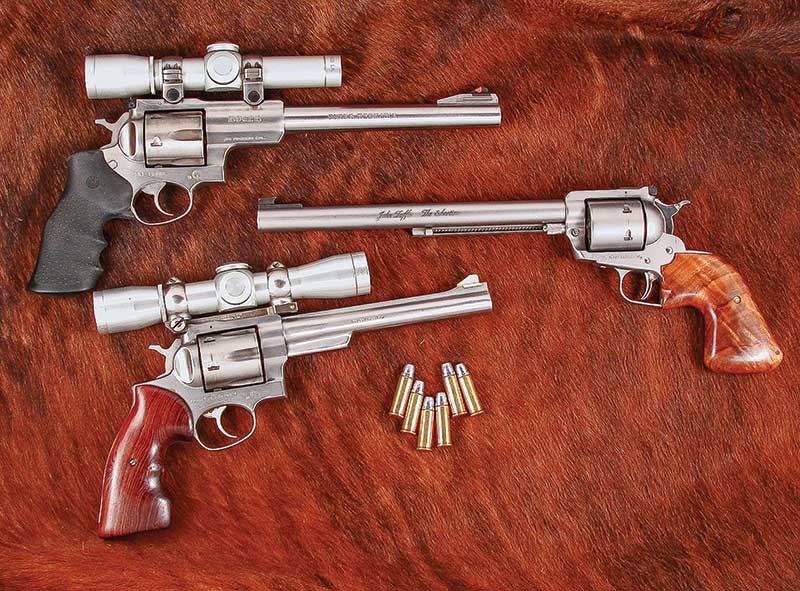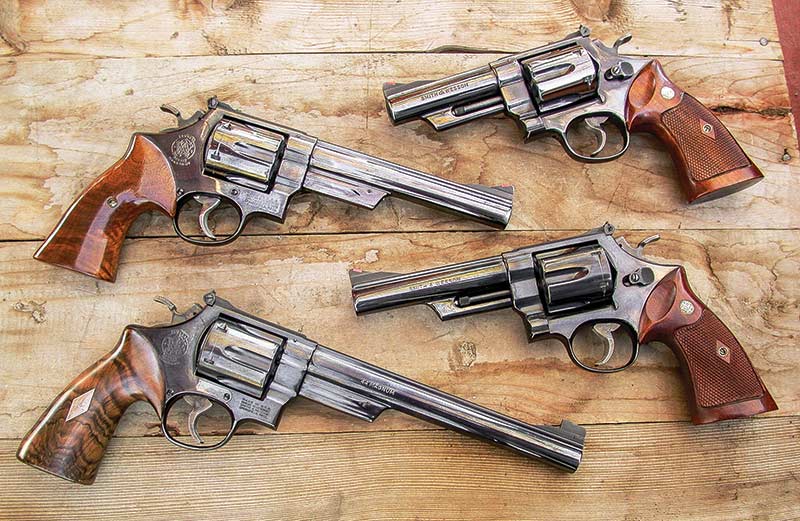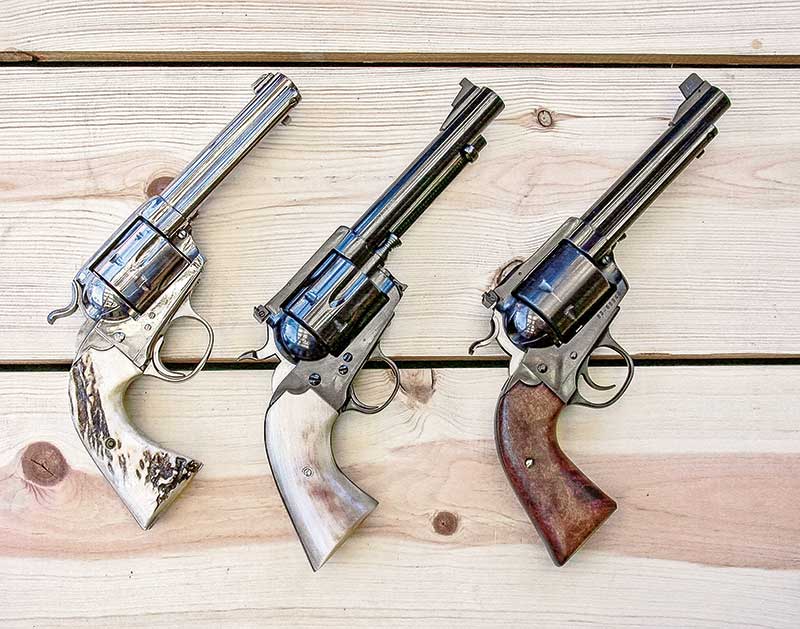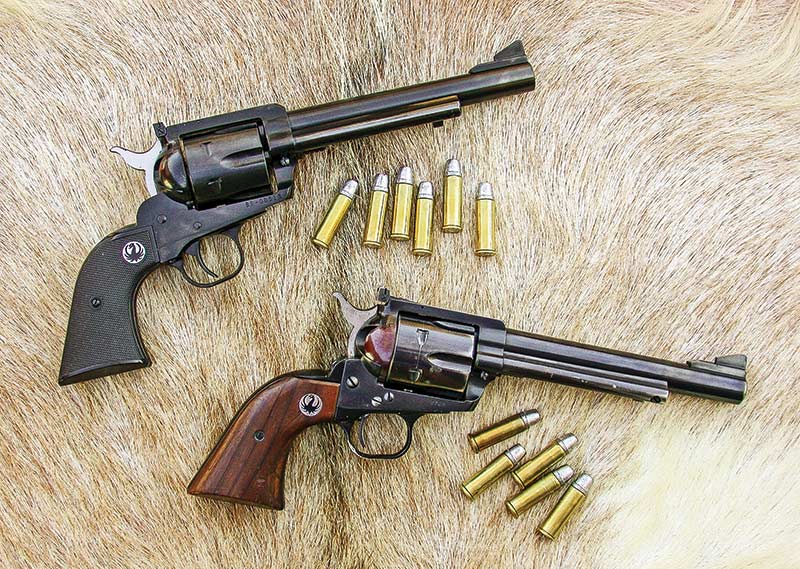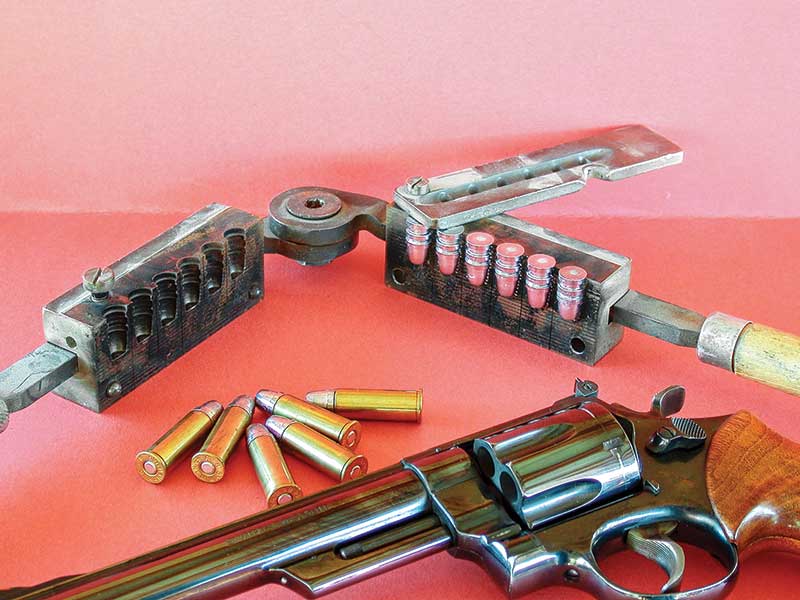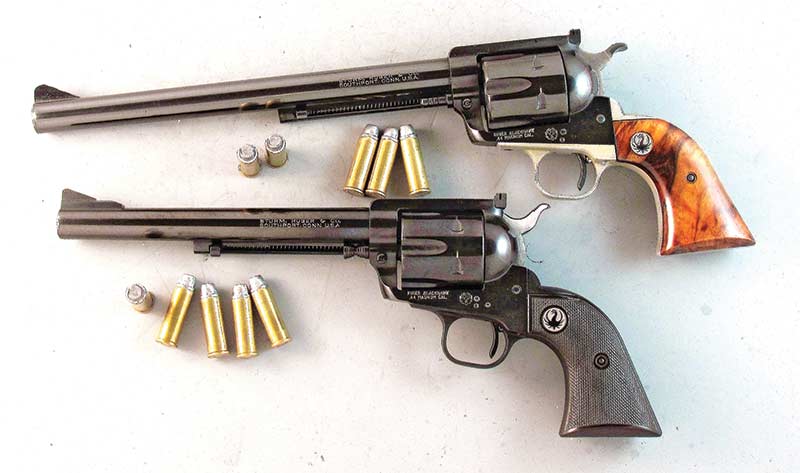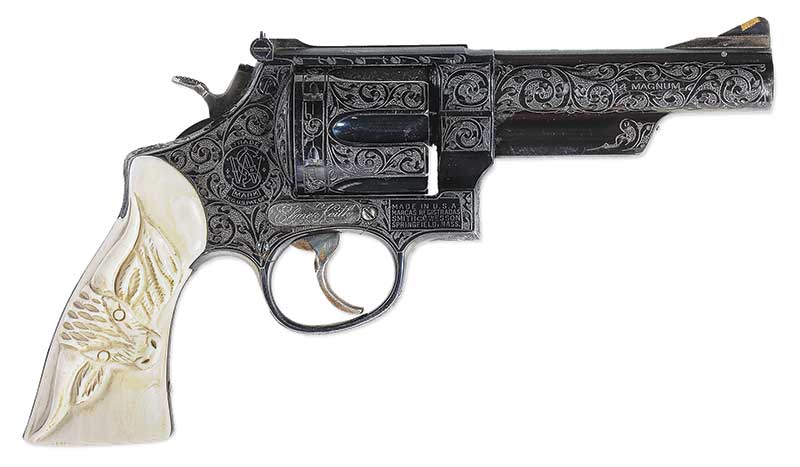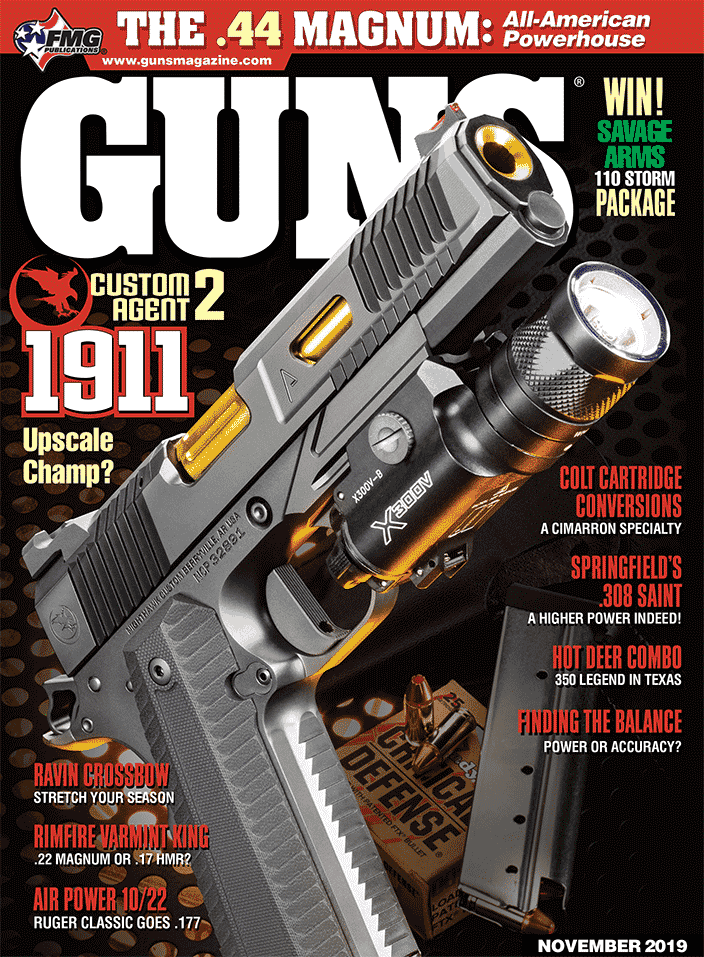The .44 Magnum Opus
History Revealed — From Somebody Who Was There!
The .44 Magnum has now been around for well over 60 years and it seems like a good time to look back at this excellent — perhaps even all around — sixgun load and the fine revolvers which have been made for it.
In The Beginning
The .44 Magnum basically begins with Elmer Keith. If you are not a reader of Keith, now would be a good time to start. Although he has been gone now for over 35 years and some of his writing is definitely dated, for much of his life Elmer was way ahead of his time. His books Sixgun Cartridges & Loads (1936) as well as Sixguns (1955) and his many articles in American Rifleman from the 1920s and 1930s make fascinating reading and are filled with real sixgun knowledge. In the closing pages of his 1955 book, Keith wrote: “We desperately need a modern, up-to-date, full powered factory loaded .44 Special — The King of all handgun cartridges.”
For 30 years, Keith had been writing about his heavy handloads in .44 Special sixguns — the Smith & Wesson Triple-Lock and 1926 Target Model along with the Colt Single Action. His standard load was 18.5 grains of #2400 under his hard cast, 250-gr. #429421 bullet loaded in the old-fashioned folded, or balloon head, cases. With the coming of modern solid head brass, he dropped his load back to 17.0 grains of #2400. Both loads yielded around 1,200 fps from 6-1/2″ and 7-1/2″ barreled sixguns.
For those same 30 years, to no avail, he had been trying to convince ammunition manufacturers to bring out his .44 Special load. Product liability is nothing new and they were afraid someone would blow an old .44 Special apart. Keith claimed there would be no problem with any Colt or Smith & Wesson heavy-frame sixgun, as he had been shooting his loads in pre-World War I Triple-Locks for years.
Somebody heard
One person who did listen was Carl Hellstrom, president of S & W in the early 1950s. He showed interest in Elmer’s pet load and discussed the prospect of a new .44 sixgun with Keith. Hellstrom asked Remington to produce the ammo and they agreed if Smith & Wesson would produce the sixgun.
The new .44 Remington Magnum was 1/8″ longer than the .44 Special. This was done so it would not chamber in .44 Special sixguns and in 1954 Smith & Wesson re-chambered four 1950-manufactured Target .44 Specials to the new round. Remington received one of the new revolvers for testing and it was soon obvious the 39-oz. weight of the .44 Target Model was too light for the recoil of the new .44 “Special-Magnum.” For all those years Elmer Keith had asked for 1,200 fps and the new round achieved 1,500+ fps, or 25 percent faster than Keith had asked for!
To provide a needed increase in weight, S&W produced a revolver with a barrel 0.15″ greater in diameter and a cylinder 0.18″ longer. This brought the weight of the 6-1/2″ sixgun up to 48 oz. or 3 lbs. By early 1955, tests were completed and S&W began tooling up to produce what at the time was simply known as the .44 Magnum. The first factory revolver was completed on December 29, 1955 and shipped to Remington. In January, the next two were completed and these went to the NRA for testing by Maj. Julian Hatcher while the other was shipped to Salmon, Idaho to Elmer Keith. By the end of 1956, more than 3,000 S&W .44 Magnums were produced in both the original 6-1/2″ length and an easier-to-pack 4″ version. The longer barreled 8-3/8″ did not arrive until 1958.
As a kid fresh out of high school, I fired one of the first of the 4″ .44 Magnums a local gun dealer had. Rather than sell it, he rented it out at six shots for 50 cents and it was a real attention getter for his range. My friends and I all fired it and lied, claiming the recoil wasn’t too bad.
Reporting in American Rifleman for March 1956, Maj. Hatcher said: “In shooting the .44 Magnum, we found it advisable to use gloves, as the recoil can only be described as severe.… I fired quite a few shots with this gun, but I must honestly confess it is not an unmixed pleasure.”
Elmer Keith, writing in the Gun Digest, looked upon the .44 Magnum quite differently than Maj. Hatcher. “The big gun is, I would say, pleasant to shoot, and does not jar the hand as much as do my .44 Special loads from the much lighter 4″ barreled .44 Special S&W sixguns … the recoil has not bothered me in the slightest nor have several old sixgun men complained.”
At the time, reading both of these reports I felt the truth was somewhere in between and I leaned towards Maj. Hatcher’s conclusion. In Elmer Keith’s report in the Gun Digest entitled “The .44 Magnum One Year Later,” he said he had fired the new gun 600 rounds the first year. This averages 12 rounds per week. There may be a lesson in there!
Then There Were Three
By 1958, .44 Magnums were available from Ruger, Smith & Wesson and Great Western as well. The Great Westerns did not last long after the factory closed in the early ’60s, leaving the only U.S.-made .44s available from Ruger and Smith & Wesson. These were the Super Blackhawk and what we know as the Smith & Wesson Model 29.
Dirty Harry changed all this. Clint Eastwood’s unrealistic portrayal of the San Francisco cop who packed a .44 Magnum created such a demand for .44s the Smith & Wessons were selling close to double their retail price.
This false demand turned out to be a good thing as other manufacturers decided to get in on the .44-craze and soon .44s were available from, by my count, 13 different manufacturers. Besides the defunct Great Western, .44 Magnum sixguns were available from Smith & Wesson, Ruger, Dan Wesson, Interarms, Mossberg (Abilene), U.S. Arms (Seville and El Dorado), High Standard (Very rare Crusaders), plus foreign .44s from Europe. Uberti contributed the Cattlemen and Dakota, along with others from Arminius, Llama, Astra, R.G., F.I.E., and Sauer & Sohn.
By now, the stage was set for .44 Magnums to become even more popular. Both Ruger and Dan Wesson took advantage of the fact they were able to build a larger and stronger double-action sixgun around the .44 Magnum cartridge. Ruger soon brought out their second double-action .44 Magnum, the Super Redhawk, which is even stronger than the almost indestructible Redhawk.
The Ruger Bisley arrived in the mid-1980s. Some of my friends in the industry said it “was an answer to a question nobody asked.” I had to disagree — at least in my hand it was a great improvement over what Elmer Keith called the Ruger Dragoon,
or Super Blackhawk. At the time, I had a pair of .44 Special Colt Bisley Models I liked very much and found the Ruger Bisley grip to be an improvement over the Colt Bisley grip.
Accuracy
What kind of accuracy can one reasonably expect from a .44 Magnum sixgun? There are three major factors involved, namely the particular sixgun, the load, and the shooter. I am not personally satisfied with any sixgun or load combination shooting less than 1″ groups at 25 yards off sandbags. Some .44s will gobble up anything and spit ’em out accurately — well, almost. Others are very picky about which load combination they will accept.
As a general rule, with some exceptions of course, I have found the harder you push ’em, the tighter they shoot. Also, generally speaking, 300-gr. bullets will normally have greater accuracy than 250-gr. or lighter bullets. I have experienced sixguns that couldn’t shoot less than 3″ groups with 250-gr. bullets but become one-holers when loaded to the max with 300-gr. bullets. The fun is in the search for the best loads.
A good .44 Magnum will shoot right alongside any other sixgun target revolver. Elmer Keith always said the true test of any sixgun is shooting long range. The .44 Magnum can be loaded accurately enough to keep 10 out of 10 shots on a silhouette ram’s body at 225 yards. Loaded with 300-gr. bullets at 1,300 to 1,400 fps, it becomes a premier hunting handgun when used with common sense and reason. Chopped and channeled to become a 3″ “belly gun” and again properly loaded, it is a highly effective defensive weapon. There are so many excellent jacketed bullets and cast bullets available it would take more than a lifetime of shooting to cover all the possibilities.
Col. Charles Askins once stated the .44 Magnum should have been still-born. I’m certainly glad it wasn’t.
